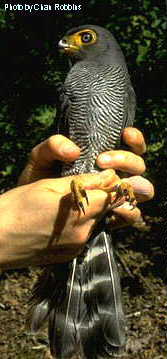|
| 질의: falconiformes | 결과: 120번째/145 | |
Barred Forest-falcon (Micrastur ruficollis) - Wiki
| 제목: | Barred Forest-falcon (Micrastur ruficollis) - Wiki
| |

| 해상도: 167x359
파일크기: 12750 Bytes
등록시간: 2008:02:01 17:08:22
|
Barred Forest-falcon
From Wikipedia, the free encyclopedia
Order: Falconiformes
Family: Falconidae
[Photo] Barred forest-falcon, Micrastur ruficollis . Photo by Chan Robbins. Source: USGS (www.mbr-pwrc.usgs.gov/id/mexlist1.html).
The Barred Forest-falcon (Micrastur ruficollis) is a species of bird of prey in the Falconidae family, the falcons, caracaras, etc. It is found in Argentina, Belize, Bolivia, Brazil, Colombia, Costa Rica, Ecuador, El Salvador, French Guiana, Guatemala, Guyana, Honduras, Mexico, Nicaragua, Panama, Paraguay, Peru, Suriname, and Venezuela.
In Central America, the Barred Forest-Falcon is generally restricted to mature tropical forests. In South America, however, the Barred Forest-Falcon lives in other kinds of forests. For example, in Amazonia it occurs most often in second-growth forests, gallery forests, tidal swamp forests, semideciduous forests and forest edges. In Acre, Brazil, the Barred Forest Falcon is reported to prefer "disturbed forest" types, both natural secondary and man made, including bamboo and more open seasonally drier forest on rocky outcrops.
Description
The adult male is dark slate grey above; his tail tipped with white and having three narrow white bars. The throat is pale grey, shading to the darker slate of the crown. The rest of his under parts, including the under-wing coverts are white, finely and clearly barred with black. The upper breast is a darker grey. Primary flight feathers are dark brownish grey with off-white bars on the inner webs. The eyes are light orange brown; the bill black, becoming dull yellow at base of the lower mandible; the cere, lores, orbit and legs are orange-yellow.
Habitat
Barred Forest-Falcons mainly utilize mature, "upland" forest. Forest-falcons, like most falconids, do not build a nest, but lay their eggs in cavities in trees. Clutches are of two or three eggs. Laying occurs mainly late in the dry season, with hatching taking place at the onset of the rainy season, a time of increasing prey abundance. Eggs hatch 33-35 days after being laid, and nestlings fledge 35-44 days after hatching. Radio-tagged fledglings dispersed from their parents' territories within four to seven weeks after fledging, presumably achieving independence at that time. Nesting territories were occupied year after year. There is high nest and mate fidelity.
Diet
This species feed primarily upon birds, mammals and reptiles. Like Accipiter hawks, they often hunt prey by sitting quietly on tree branches and waiting for their victims to appear. When the latter arrive, the forest-falcons quickly ambush them, attempting to catch them with a brief, flying pursuit. However, forest-falcons also use other techniques to hunt prey, such as chasing prey on foot, following army ant swarms, and acoustical luring of birds, by means of a "facial disc".
http://en.wikipedia.org/wiki/Barred_Forest-falcon
| The text in this page is based on the copyrighted Wikipedia article shown in above URL. It is used under the GNU Free Documentation License. You may redistribute it, verbatim or modified, providing that you comply with the terms of the GFDL. |
|
^o^
동물그림창고 똑똑전화 누리집
^o^
|
|